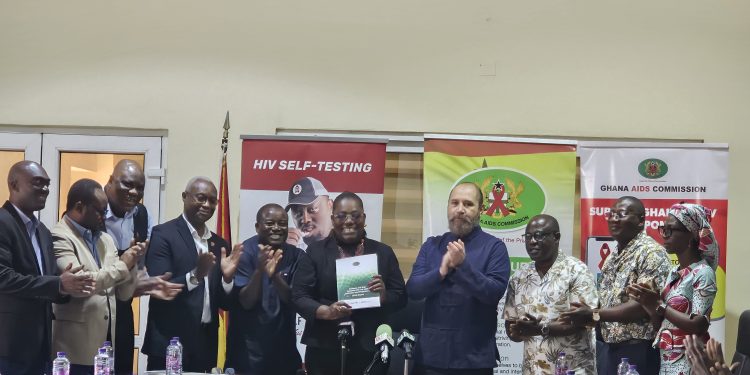Ghana records about 42 new HIV infections per day. This translated into 15,290 new HIV infections in 2024.
It comprises 1,243 children under 15 and 14,047 adults aged 15 and above.
The 2025 National and Sub-National HIV Estimates and Projections report, launched in Accra, shows that 12,614 AIDS-related deaths were recorded in 2024.
The report, which outlines Ghana’s HIV landscape for 2024, revealed that 334,721 people are currently living with HIV in the country.
Women continue to be disproportionately affected, making up 68.5% (229,261) of the total number of people living with HIV, compared to 31.5% (105,460) for men.
The adult HIV prevalence rate (ages 15–49) stands at 1.49%, with women again bearing a heavier burden of new infections.
In 2024, females accounted for 67.4% (10,303) of new HIV cases, while males represented 32.6% (4,987).
The age breakdown of those living with HIV also indicates that the epidemic continues to affect adults more significantly.
Adults aged 15 and above make up 94.6% (316,492) of the total population living with HIV, while children aged 0–14 account for 5.4% (18,229).
Alarmingly, 69% of these adult infections are among women, and 34% affect young people (15–24 years old)—28% of whom are young women.
Despite notable strides in Prevention of Mother-To-Child Transmission (PMTCT), with 99.3% of HIV-positive mothers accessing services to protect their babies, only 47.5% of people living with HIV are on antiretroviral therapy (ART).
This has left an estimated 107,128 people unaware of their HIV status, posing a challenge to Ghana’s HIV elimination goals.
ART is working, however—229 deaths were averted every week, contributing to a total of 12,358 lives saved in 2024 alone.
Deaths and disparities
AIDS-related deaths also reflect a gendered and age-specific pattern.
Adults accounted for 89.5% (11,289) of all AIDS-related deaths in 2024, while children contributed 10.5% (1,325).
Of the total deaths, 56.8% (7,159) were females, and 43.2% (5,455) were males.
Health officials attributed the continued rise in new infections to key drivers such as unprotected sex, widespread ignorance about HIV transmission and prevention, and persistent stigma that discourages testing and treatment.
Speaking at the event, Deputy Chief of Staff at the Office of the President, Nana Oye Bampoe Addo, noted the critical need for strategic investments and partnerships.
She commended the Ghana AIDS Commission and development partners for their continuous efforts and reaffirmed the government’s commitment to ending AIDS by 2030.
“These figures serve as our scientific and strategic compass.
They guide our prevention, treatment, care, and support interventions. We must not overlook the sobering reality of 12,640 AIDS-related deaths in the past year,” she said. “This should be a wake-up call.”
Ms. Bampoe Addo also revealed that only 47% of PLHIV are on ART—a gap that must be urgently addressed.
“Government is working to close the funding gap left by USAID’s withdrawal.
We’re committed to sustained domestic financing and integrating HIV into broader development strategies,” she added.
In a show of continued leadership in the HIV response, she announced that Ghana will host the 2025 International Conference on AIDS and STIs in Africa (ICASA).
“ICASA will not only showcase Ghana’s progress but also draw global partnerships and investment into our health system,” she stated.
A call to renewed commitment
The Acting Director General of the Ghana AIDS Commission, Dr. Kharmacelle Prosper Akanbong, noted the importance of accurate, reliable data in the fight against the epidemic.
He stated that the estimates are not just numbers, but reflect the progress, challenges, and the country’s collective commitment to fighting the epidemic.
Dr. Akanbong commended the substantial gains Ghana has made in prevention, treatment, and care through the efforts of health workers, policymakers, civil society, and international partners.
However, he cautioned that vulnerable populations and certain regions continue to bear a disproportionate burden, stressing that “addressing these inequities must remain at the heart of our national response.”
He explained the use of mathematical modeling tools such as the AIDS Impact Module (AIM) in Spectrum and the Naomi model—developed with support from UNAIDS—to estimate new infections, treatment coverage, and AIDS-related deaths.
These tools, he said, are crucial for tracking trends and aligning strategic planning with resource needs.
“It gives me great pleasure to announce that this year, our National Estimates Team was able to produce disaggregated HIV estimates for all 16 regions and 261 districts of Ghana,” he said, describing it as a significant milestone.
Calling for collective action, he stated: “Our journey does not end with today’s dissemination. The real measure of our success lies not only in the data we report but in the lives we impact and the future we shape for generations to come.”
The Ghana AIDS Commission, in collaboration with stakeholders, stressed the need for targeted interventions, expanded ART coverage, youth-focused awareness campaigns, and greater community engagement to curb the epidemic.












